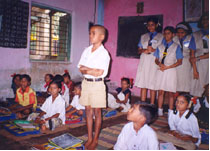 Seventy
percent of
India
lives in rural areas.
For
India
to join the legion of
developed countries, we need to focus on development
that caters to these seven hundred million people.
Thankfully, this fact is not going unrecognized at least
in some sectors. Many concerned groups and individuals
are pushing for better infrastructure for rural
India
. President, Dr Abdul
Kalam is pushing the concept of PURA (providing urban
facilities in rural areas) for this purpose. Rajesh Jain
of Indiaworld fame, Atanu Dey and Vinod Khosla, the
greatest venture capitalist on the planet are
propagating the concept of RISC (Rural Infrastructure
& Services Common).
Seventy
percent of
India
lives in rural areas.
For
India
to join the legion of
developed countries, we need to focus on development
that caters to these seven hundred million people.
Thankfully, this fact is not going unrecognized at least
in some sectors. Many concerned groups and individuals
are pushing for better infrastructure for rural
India
. President, Dr Abdul
Kalam is pushing the concept of PURA (providing urban
facilities in rural areas) for this purpose. Rajesh Jain
of Indiaworld fame, Atanu Dey and Vinod Khosla, the
greatest venture capitalist on the planet are
propagating the concept of RISC (Rural Infrastructure
& Services Common).
The rest of the world
is today taking
India
seriously because of its
enviable growth in the knowledge economy, especially in
IT, Software and Pharmaceuticals. IITs are recognized
around the world for their ability to instill a world
class education in one of the worldís poorest nations.
Rural
India
needs to join this
knowledge economy. One
of the primary enablers for them to do this is
education.
However, a closer look
at rural education today shows that it suffers on
several counts. First,
90 percent of schools across the country are run by
central, state and local governments.
In rural areas, there is no adequate
infrastructure. If the infrastructure exists the
teachers are missing. If both exist, the teachers are
untrained, and the quality of teaching suffers.
Curriculums are unsuited for training students for
adulthood and this leads to high percentage of drop
outs. There is no ownership from the community and hence
no accountability from the people who are involved in
delivering rural education. The facts speak for
themselves. In
four of the most populous and under-developed states of
the country (
Bihar
, Madhya Pradesh,
Rajasthan and Uttar Pradesh) 31% of primary schools
donít have a pucca building, 20 % are single-teacher
schools, 56% donít offer potable water and 70% percent
are without toilet facilities. Little wonder that of the
146 million children who enroll in primary schools
nation-wide annually, 59 million drop out before they
reach class VIII.
To sum it up, the
school system in rural
India
is today in a pathetic
situation.
Compare this to urban
India
. Apart from government
schools there are now a large number of private schools.
Though many of these promoters can be accused of profit
motives still it canít be denied that many of the
private schools provide a superior infrastructure,
better trained teachers and well defined system of
conducting classes and examination etc.
Why donít we have
such private initiatives in rural education? This is
easy to answer. Rural
schools are not economically attractive for the private
sector. An
urban school with a student population of two to three
thousand in a second grade city in
India
can generate a surplus
of Rs 50 lakhs to Rs 1 crore, while a rural school
canít even manage its revenue expenses from the fee it
can collect from students. This deters private
initiative in rural education.
The responsibility falls on notoriously
unreliable state governments, who are required to offer
free education to its citizens at the primary level.
But with millions of students with no schools,
the government has not been able to fulfill its
promises.
So can there be a
private initiative to offer quality education to rural
students at a fee that students can afford?
One of the ways is to couple micro industries
with rural schools.
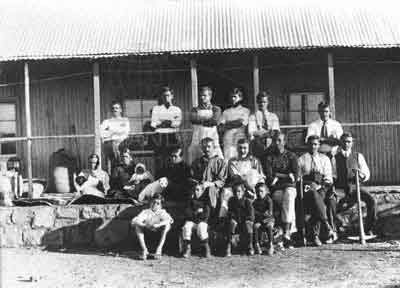 Gandhiji
was involved in education on Tolstoy Farm (see photo)
in
South Africa
.
Students learnt subjects like mathematics,
geography, and literature while working on farms
producing crops and vegetables.
Dayalbagh
College
in
Agra
also has similar
arrangement. PSG Charitable Trust in
Coimbatore
runs an industry along
with its engineering college and other institutions.
This industry (PSG Industrial Institute- PSGII) produces
motors, pumps, fans and many other tools. There is a
symbiotic relationship between PSGTech and PSGII.
The profits from PSGII go into building
infrastructure for PSGTech and other institutions while
students of PSGTech work as apprentices in PSGII and
gain valuable work experience. The faculty of PSGTech
acts as resources for PSGII and help in designing and
developing new products.
Gandhiji
was involved in education on Tolstoy Farm (see photo)
in
South Africa
.
Students learnt subjects like mathematics,
geography, and literature while working on farms
producing crops and vegetables.
Dayalbagh
College
in
Agra
also has similar
arrangement. PSG Charitable Trust in
Coimbatore
runs an industry along
with its engineering college and other institutions.
This industry (PSG Industrial Institute- PSGII) produces
motors, pumps, fans and many other tools. There is a
symbiotic relationship between PSGTech and PSGII.
The profits from PSGII go into building
infrastructure for PSGTech and other institutions while
students of PSGTech work as apprentices in PSGII and
gain valuable work experience. The faculty of PSGTech
acts as resources for PSGII and help in designing and
developing new products.
There are more
examples. Similar experiments have been carried out in
some schools in
China
. One school runs a
popular restaurant where students have been working for
last few years. In
India
, similar experiment has
been carried out in rural Karnataka, where one school
prepares fresh flower garlands, and in
Gujarat
, where one school was set up so as to generate revenues from the farm
and dairy it maintained through the efforts of its
students. These
are a few examples, but it offers significant potential.
Can inspirations be
drawn from these examples for coupling micro industries
with rural schools? Yes.
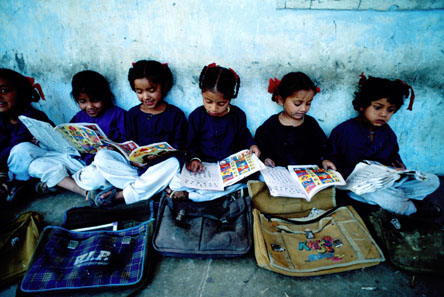 The
term ďmicro industriesĒ needs to be defined first.
Any income generation activity that suits the local
context can be termed as micro industry. For example, a
school can carry out mushroom farming and that can be
treated as a micro industry. A news article in India
Today informed that mushroom farming by village women in
Assam
has changed the economic
status of many rural families in
Assam
. A big tailoring firm
attached with a school that can produce shirts, pants
and other clothes which can be sold in nearby rural
areas can also be termed as a micro industry. In fact a
school in a nice scenic setting can start eco-tourism
facilities and generate resources.
The
term ďmicro industriesĒ needs to be defined first.
Any income generation activity that suits the local
context can be termed as micro industry. For example, a
school can carry out mushroom farming and that can be
treated as a micro industry. A news article in India
Today informed that mushroom farming by village women in
Assam
has changed the economic
status of many rural families in
Assam
. A big tailoring firm
attached with a school that can produce shirts, pants
and other clothes which can be sold in nearby rural
areas can also be termed as a micro industry. In fact a
school in a nice scenic setting can start eco-tourism
facilities and generate resources.
The coupling of micro
industries with schools can create many benefits. It can
generate surpluses that can partially or completely
fulfill the resource requirement of the school. It
provides technical training to students and promotes the
concepts of leadership, teamwork and entrepreneurship.
It has also resulted
in lowered drop-out rates. Students drop out from
schools since they donít see any value from the
education imparted. In Bhubhaneswar, poor parents are
not willing to send their children to schools because
each child can earn an extra income of rupees 100 a day
if they work at the butchering shop instead.
A micro school could
significantly change behavior.
It could set up a unit to teach students to
process the meat, and teach concepts that would allow
them to export to other parts of the country or even
overseas. Then surely parents would like to send their
children to that school. The training in the attached
micro industry may also encourage students to set up
enterprises if they are not very academically inclined,
or to continue to work there after graduation.
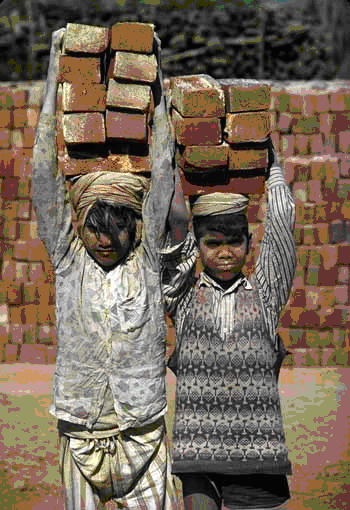 A
state like Orissa with widespread poverty, illiteracy
and unemployment needs more micro industries than big
industries. Big industry employs high technology and
few, highly skilled people. Experience has shown that
not much downstream industry comes up in the immediate
vicinity of these larger industries. On the other hand,
small industries suited to available local resources and
local requirements can be viable, involve large numbers
of people and initiate large scale economic activities.
A
state like Orissa with widespread poverty, illiteracy
and unemployment needs more micro industries than big
industries. Big industry employs high technology and
few, highly skilled people. Experience has shown that
not much downstream industry comes up in the immediate
vicinity of these larger industries. On the other hand,
small industries suited to available local resources and
local requirements can be viable, involve large numbers
of people and initiate large scale economic activities.
A visit to villages in
interior of Orissa revealed that people there had no
clue regarding what kind of micro industries could be
set up and they had no information from where the
technology could be brought.
Schools can help in this direction by being role
models, extending the knowledge about possibilities and
becoming sources for creating entrepreneurship in
villages.
By putting these rural
schools into a larger network, schools can have access
to larger human resources and technology. The network
can float a few rural technical schools that can impart
necessary technological training to people wishing to
pursue entrepreneurship. In fact the network can float a
marketing arm and a common brand name that can help
micro industries attached with schools to sell their
produce easily and at a better price. The network can
even collaborate with micro financing companies to
provide much needed financial resources to
entrepreneurs.
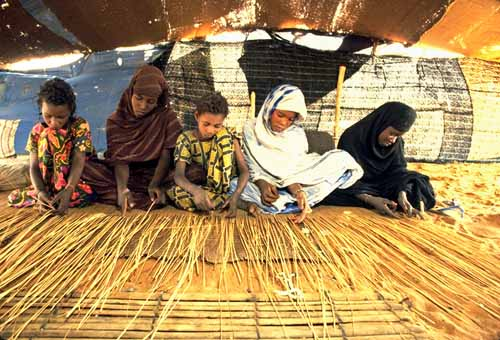 All
this costs money. Government
as well as private sponsorship could be better spent by
providing the seed funds for sustainable schools in
rural
India
, creating an employment
and skill set revolution.
If more minds give serious thoughts about this
concept more creative solutions can be brainstormed.
Only then can rural education be made more
meaningful and vibrant, and the economic status of
villages can be improved to a great extent.
All
this costs money. Government
as well as private sponsorship could be better spent by
providing the seed funds for sustainable schools in
rural
India
, creating an employment
and skill set revolution.
If more minds give serious thoughts about this
concept more creative solutions can be brainstormed.
Only then can rural education be made more
meaningful and vibrant, and the economic status of
villages can be improved to a great extent.
Then truly a developed
India
can emerge!
To
learn more, please email me: laxman_mohanty@yahoo.co.in
Photo credits: UN.org

